

Backpacking in Scotland offers immense variety for outdoor enthusiasts, from the rugged hills of the Highlands to the windswept islands of the Hebrides, including popular destinations like the Cairngorms National Park.
And that’s what this post is all about – backpacking in Scotland. We’ll provide tips to help you prepare for backpacking in this diverse country as well as showcase the TOP 5 multi-day trails in Scotland.
From rolling green glens to dramatic sea cliffs, Scotland’s landscapes provide spectacular backpacking opportunities. Whether you’re an experienced thru-hiker or new to backpacking in Scotland, the tips and trails highlighted in this guide will inspire your next adventure in this beautiful country.
Let’s get started.
Explore Scotland’s best scenic long trails for epic adventures:

Length: 95.4 mi / 153.5 km
Type: Point to point
Difficulty: Hard
Elevation Gain: 13 963 ft / 4256 m
Location: Glasgow
Estimated Hiking Calorie Burn: 23 000 calories
More Details: See on AllTrails
Traverse 95 miles of rugged Scottish wilderness on the West Highland Way from Milngavie to Fort William. Follow old railway lines, traverse high mountain passes, and marvel at lochs, glens, and lush green valleys. Camp along the trail or stay in small towns and villages. Highlights include Conic Hill’s panoramic views, the expansive shores of Loch Lomond, the Devil’s Staircase descent into Glencoe, and finishing under the mighty Ben Nevis. Challenging but rewarding, with ever-changing scenery from forests to moors to mountains, it’s a classic Scottish thru-hike. Allow 5-7 days to fully experience this iconic trail.

Length: 73.2 mi / 117.8 km
Type: Point to point
Difficulty: Hard
Elevation Gain: 10 298 ft / 3139 m
Location: Fort William
Estimated Hiking Calorie Burn: 17 500 calories
More Details: See on AllTrails
Hike from coast to coast across Scotland’s Great Glen on this 73-mile thru-hike from Fort William to Inverness. Pass deep blue lochs, rolling green hills, and historic battlegrounds. The well-marked trail follows old military roads, canal towpaths, and forest tracks through rugged yet stunning scenery. Highlights include majestic Ben Nevis, mythical Loch Ness, medieval Urquhart Castle ruins, and Caledonian pine forests. With changing terrain from loch-side strolls to mountain ascents, the Great Glen Way challenges hikers with a taste of the diverse Scottish Highlands. Allow 4-6 days to fully experience this point-to-point adventure across the heart of the Scottish Highlands.

Length: 80.3 mi / 129.2 km
Type: Point to point
Difficulty: Hard
Elevation Gain: 12 631 ft / 3850 m
Location: Loch Lomond and The Trossachs National Park
Estimated Hiking Calorie Burn: 22 000 calories
More Details: See on AllTrails
Travel through the Scottish Highlands on this challenging 80-mile thru-hike from Drymen to Pitlochry. Follow in the footsteps of folk hero Rob Roy MacGregor along rugged paths, forestry tracks, and quiet country roads. Pass lochs, glens, and forests surrounded by stunning mountain scenery. Highlights include Loch Lomond, the Trossachs, and Rannoch Moor. With changing terrain and some road walking, sturdy boots are recommended. Wild camp or stay in villages along the route. Allow 5-7 days to complete this point-to-point trek through iconic Scottish landscapes with historical connections to the elusive Rob Roy.

Length: 79.9 mi / 128.6 km
Type: Point to point
Difficulty: Hard
Elevation Gain: 13 248 ft / 4038 m
Location: Isle Of Skye
Estimated Hiking Calorie Burn: 19 200 calories
More Details: See on AllTrails
Traverse the rugged beauty of Scotland’s largest island on this challenging 80-mile thru-hike across the Isle of Skye. Pass stunning sea cliffs, ascend the iconic pinnacles of the Old Man of Storr and Quiraing, and marvel at views of the Cuillin peaks. Ramble through glens tucked between the Red and Black Cuillins before descending to Elgol’s dramatic coastline. With few services along the way, prepare for self-sufficiency. Pass through idyllic fishing villages to resupply. Allow 6-7 days to fully experience the magic of Skye on this unmarked but rewarding point-to-point trail across an iconic Scottish landscape.

Length: 233.9 mi / 376.4 km
Type: Point to point
Difficulty: Hard
Elevation Gain: 43 021 ft / 13 113 m
Location: Fort William
Estimated Hiking Calorie Burn: 56 700 calories
More Details: See on AllTrails
Embark on this grueling 234-mile trek from Fort William to Cape Wrath, one of Britain’s toughest and most remote thru-hikes. Traverse wild Scottish terrain devoid of trails or signs on this unmarked route requiring expert navigation skills. Ford rivers, traverse soggy bogs, and skirt cliffs along the dramatic northwest coast. With few resupply options, prepare to be completely self-sufficient. Expect solitude and sweeping vistas of rugged beauty. The Cape Wrath Trail’s difficulty should not be underestimated, but completing it offers immense reward for hardcore backpackers seeking Scotland’s wildest landscapes and a true adventure. Allow 2-3 weeks for this challenging yet magical odyssey.
Scotland also has a temperate maritime climate, but with some regional variations. Here’s a general overview of the weather throughout the year:
Prior to making gear selections, it’s advisable to review the annually recorded weather data in Scotland:
| Jan | Feb | Mar | Apr | May | Jun | Jul | Aug | Sep | Oct | Nov | Dec | |
|---|---|---|---|---|---|---|---|---|---|---|---|---|
| High °F | 43 | 45 | 46 | 50 | 55 | 61 | 64 | 64 | 61 | 54 | 48 | 43 |
| Low °F | 34 | 34 | 36 | 36 | 41 | 48 | 50 | 48 | 46 | 41 | 36 | 34 |
| Rainy days | 18 | 15 | 15 | 13 | 12 | 13 | 13 | 14 | 14 | 17 | 18 | 18 |
Not sure if Scotland is right for you?
Don’t forget to check out our backpacking guides for England and Wales.
While backpacking in Scotland, you can have a campfire provided you follow some basic guidelines. Fires are permitted in most areas, but always check for any local restrictions. Use an established fire pit if there is one. Otherwise, clear a 10 foot diameter area of combustible material and don’t burn trash or anything with toxins. Make sure the fire is fully extinguished and cold to the touch before leaving it unattended. And of course, exercise caution – don’t overlook basic fire safety.
When encountering wildlife while backpacking in Scotland, it is important to admire animals from a safe distance and not disturb their natural behaviors. Give large grazing animals like deer, cows, and horses a wide berth and move slowly to avoid startling them. Be aware of adders in summer and keep dogs leashed and under control. Never feed wild animals. Back away if an animal shows signs of aggression. In general, educate yourself on local wildlife, hike in small groups, and make noises while walking to avoid surprise encounters.
Always check the weather forecast before your trip and be prepared for changing conditions, as the climate can be unpredictable. Proper clothing and rain gear is a must. Leave your route and estimated return time with someone trusted. Be sure to carry essential equipment like navigation tools, first aid supplies, headlamp/flashlight, water purification, and emergency shelter. Watch out for uneven terrain and boggy ground which can pose trip hazards. Take extra care near cliff edges and bodies of water. Be aware of tick-borne illnesses in spring and summer and check yourself thoroughly after outdoor activity. Most importantly, respect any warning signs and access restrictions, as remote areas do not always have immediate emergency support.
U.S. citizens do not need a visa to visit Scotland. As part of the United Kingdom, Scotland is covered by the visa waiver program that allows U.S. citizens to visit the UK for up to 6 months without a visa for purposes of tourism, visiting family or friends, or business trips. As long as they have a valid U.S. passport, travelers from the United States can enter Scotland without applying for a visa.
Packing for a backpacking trip in the beautiful nature of Scotland requires choosing gear that will allow you to comfortably trek outdoors. Be sure to pack a quality tent, sleeping bag, and backpack to carry everything you need. Don’t forget essential navigation tools like a compass and map. Be ready for rain, so bring waterproof gear. Wear layers to adjust to different weather. From our experience, having an insect head net is crucial.